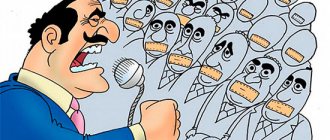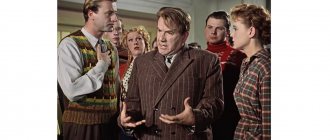Leading a company or a small team is equally challenging. The previously popular authoritarian power of the boss presupposed, first of all, the strict implementation of his decisions. This management feature did not give employees a chance to voice their opinions or criticize the manager. As practice shows, the democratic leadership style (DSM) of a team can bring much more benefits than the “stick” method.
The manager and employees solve the problem
Authoritarian leadership style
The authoritarian (directive, totalitarian) style of team management means that all power in the enterprise is concentrated in the hands of one person - the manager. Whatever he decides, so it will be. The opinion of the staff is not taken into account and has no significance.
The authoritarian style presupposes the presence of very strict discipline in the team. The enterprise creates a large number of instructions and orders that employees must strictly follow. There is also a powerful system of personnel incentives: for the slightest violations and failure to comply with directives, employees are fined financially or punished in some other way. Staff are afraid to do work on time or with poor quality, which encourages them to work more efficiently and productively.
Employees of an enterprise with an authoritarian leader do not take any part in management, cannot take initiatives, they are only forced to obey. Any steps without the knowledge and approval of the boss are simply unacceptable.
There are many disadvantages to be found in an authoritarian leadership style. First of all, it requires a lot of time, mental, and physical investment from the manager. Because all decisions fall solely on him, and the larger the enterprise, the more difficult it is to manage it in this style.
The totalitarian style is often accompanied by bureaucracy, because the manager simply does not have enough time to pay attention to all employees. Therefore, resolving issues, including
important, takes a lot of time, in this case you will have to forget about efficiency.
Also, an authoritarian style, as a rule, causes disapproval among employees; not everyone wants to work under such leadership, so there may be dissatisfaction and high staff turnover in the team, which also negatively affects the work process.
A leader who has chosen a directive style needs to be careful not to “revel in his own power” to the detriment of his enterprise.
Direction and functions of management
In addition to leadership style, it is customary to highlight focus. It reflects the manager’s priorities in the performance of general functions. According to this, the orientation can be distinguished:
- to solve production problems;
- to primarily solve socio-psychological problems;
- for optimal solutions to current problems.
The main functions of a manager, in turn, include goal setting (setting goals, comparing them with real conditions, changing tactics if necessary), planning and forecasting (selecting optimal ways to achieve a goal), organization (creating a flexible, economical, self-regulating, reliable and operational system of one the whole, coordination and regulation (adjustment, polishing of the organized system), stimulation, control, accounting and analysis.
Types of DSR, their comparison
Democratic style has two types:
- advisory;
- participative.
Each of them is characterized by its own set of conditions for organizing work.
Advisory
The boss, trusting his employees, consults with his subordinates before making decisions or setting tasks. In the process of such communication, the manager selects the best and most valuable proposals. Based on them, tasks are formed. With this approach, employees receive satisfaction from the fact that they can support their boss and point him in the right direction. As a result, no one is bothered by the fact that instructions come from above. Good offers are usually followed by encouragement.
Advisory type of DSR
Participative
This democratic type of leadership is built on the fact that the boss does not consult, but completely delegates the consideration of assigned tasks to the group, ensuring the involvement of all interested employees for constructive proposals. They are also entrusted with control over the fulfillment of the formed goal.
Participative type of DSR
Kinds
Democratic management has formed several directions in the “manager-subordinate” relationship. It includes the following varieties:
- Participative. The manager completely trusts his subordinates, consults with them on issues related to the company's activities, uses constructive suggestions from employees and involves them in setting specific goals. Responsibility for the results of decisions made is not transferred to subordinates.
- Advisory. The manager only consults with his subordinates and in the process tells them the most correct solutions, but leaves the main steps to himself. Employees are satisfied with the organization of the process, provide assistance and support to the manager. Reward stimulates employees, and punishment is practically not used.
Democratic style of any variety is acceptable for companies where employees are well versed in the production process, and in some cases even better than the manager. Let's consider an example: a young specialist arrived at the company. He builds a democratic relationship with his subordinates, listens to their advice, taking into account their professionalism and knowledge. He relies on the experience of his subordinates, and they assist him in making important decisions.
Consequences of an incorrectly chosen style
All people make mistakes, without this it is impossible to move forward. However, when it comes to choosing a leadership style, such failure can be costly to the company in every sense.
The chosen leadership style depends on:
- Psychological climate in the team. Here, everything is usually fine with the leaders of the democrats, but the subordinates of the dictators, driven by fear, feel undervalued, lose interest, and work “from the fence to the dinner.”
- Staff turnover. The first point leads to the second. The best employees, dissatisfied with the management style, leave, leaving mediocre opportunists, as well as retirees who are accustomed to the fact that the boss can be anyone since their youth.
- Sabotage of tasks. This problem can occur with any leadership style, but it manifests itself in different ways. Subordinates of tough leaders are characterized by the ability to “roll what’s square and carry what’s round,” so to speak. They could come up with a much more efficient way, but they're just doing what they're told. With democratic leaders, some subordinates feel permissive and begin to answer any questions with endless “I’m already doing it” and “I’ll finish it tomorrow.”
- The presence of new ideas that are necessary for the development of the company, like air. If they are generated by only one person (the director), they gradually lose their novelty. All this leads to the fact that the organization stands still. In conditions where competitors are running forward, this is actually equivalent to walking backwards.
- The ability to pull together and act as one in difficult times. This usually arises with difficulties if the leadership style is too democratic. The right of the last word should always remain with the leader.
Advantages of the management technique
Democratic leadership style is a special style of building relationships between subordinates and superiors, based on mutually beneficial cooperation between them. It has more strengths than other management models.
The advantages of this approach to people management include:
- lack of concentration of all power in the hands of just one manager;
- When making decisions, the manager does not act alone, but consults and confers with his subordinates;
- Delegating work tasks to their subordinate democrat managers is a common practice. At the same time, competent managers try to develop leadership skills and initiative in employees;
- the manager does not impose his opinion on his subordinates; there is a pluralism of opinions when resolving work issues;
- the leader’s attitude towards employees is respectful, while the interests of each individual team member are as important as the general interests of the company as a whole;
- there are opportunities for the development of each employee;
- This model is characterized by lower staff turnover;
- As a result, a generally favorable climate in the team develops, built on the principles of complicity and goodwill.
The main advantage of a democratic approach to people management is that managers give every employee the opportunity to speak out.
Unlike an authoritarian regime, in which the opinions of subordinates are ignored and left unattended, with this approach it is possible to avoid the unfulfillment of employees. This, in turn, has a positive effect on staff turnover, which, although it does occur under democratic leadership, is still much less than under autocracy.
Authoritarian-democratic style
The presence of undeniable advantages of collegial management does not mean that the authoritarian style has been “discarded.” In management practice, a combined leadership style is actively used - “authoritarian-democratic”, combining the advantages of the two styles.
A complex approach containing contradictions at its core. What should you prioritize: creativity (democratic methods) or discipline (organizational methods)? The selection of the main parameter for a particular situation is carried out by ranking factors or a combination of methods. For example, maintaining democracy in the decision-making process and authoritarianism at the stage of their implementation.
Advantages and disadvantages
The democratic position of the leader, equally with the authoritarian and liberal positions, has its pros and cons.
The advantages include the following:
- complete trust in the staff and mutual understanding;
- involving employees in the life of the company;
- team spirit unites and motivates the employee’s independence within the framework of his job responsibilities;
- joint decisions do not cause much dissatisfaction among employees;
- Non-standard approaches allow us to find answers to any given tasks.
The advantages include low staff turnover, job satisfaction and a favorable climate in the organization.
Attention! The decision-making procedure in a democratic leadership style (DSM) occurs at all levels of communication, both vertically (among managers) and horizontally (within the team). One of the disadvantages of a democratic leadership style is the frequent difficulty in making a common decision and its correctness.
In addition, the following can be considered as negative points:
One of the disadvantages of a democratic leadership style is the frequent difficulty in making a common decision and its correctness. In addition, the following can be considered as negative points:
- inability to make quick decisions in emergency situations;
- lack of strict centralization of control;
- emergence of new requirements for management quality.
Improper management of a manager can lead to abuse of freedom and manipulation by subordinates.
Examples from life
Knowledge of the basics and rules of leadership styles is not a guarantee of successful company management, since they require reasonable application in the current situation, taking into account all factors of internal and external space. In this regard, the thoughtless hope that the democratic style of management contributes to the resolution of controversial (mostly critical) situations leads, as a rule, to an apocalypse rather than an apogee. Practice shows that only a skillful, timely change in leadership style to the one most suitable for the current situation allows one to emerge from any “storms” in the business sphere. Examples of successful application of the democratic management style indicate its great potential in the field of innovation and development.
Thus, during the stagnation of the BMW military campaign, a decision was not made to close it due to the cohesion and enthusiasm of the workforce. The employees committed to release a new brand of passenger car (to replace aircraft engines), developing lines of different classes. This is how the cars of the famous BMW brand saw the world.
According to the head of Philips, Albert van Griede, the fundamental principle of his company (personal interest) is only possible with a democratic management style.
As can be seen from the examples, the type of leadership under consideration is successfully used in creative and artistic fields of activity. However, there are many more examples of mixed style.
Liberal leadership style
The liberal (permissive, anarchic) style of team management involves providing employees with almost complete freedom of action, with the main condition: the assigned task must be completed.
How exactly the employee will perform his assigned duties, when he will come to and leave work, what he will do during working hours - all this is of secondary importance, the main thing is to do what the manager has instructed.
The liberal leadership style is most often used in teams of some creative enterprises (for example, those involved in organizing holidays, show performances, etc.).
At enterprises with a liberal leadership style, there is the highest risk of a drop in discipline and morale of the team, however, it is worth recognizing that for many people (say, for representatives of certain professions or simply a certain psychological type), this style is best suited - with it they will be best do their job, and will remain highly loyal to the organization and its leader.
In conclusion, I would like to emphasize once again: which team management style to choose is a purely individual question. The choice should depend on the specifics of the company’s activities, the size of the team, and the characteristics/preferences of the manager himself. It is also possible, to some extent, to combine different styles of company management: in practice, this is most often what happens.
That's all. Success and prosperity to your business! See you again on Financial Genius - a site that will become your guide to the world of finance.
Inconsistent style
Leaders who suffer from this style tend to jump from one style to another. They then begin to strictly control the work, then they let go of control so much that their subordinates begin to organize complete self-government and anarchy. But sometimes healthy democracy emerges in such a team. Such tilts in one direction or the other give the company instability in the market, ensure inconsistent implementation of all planned actions, and non-compliance with company policies.
The effectiveness of management is low, and most often it is managed in this way by unprepared, impulsive people who once studied management, but did not finish their studies. In a team with such management there are always a lot of conflicts, work or personal problems.
Examples of an authoritarian management style
One of the most striking and illustrative examples of the benefits of an authoritarian approach to management is Henry Ford. He selected employees very meticulously, delving into every detail of their biography.
In addition, Ford's strengths have always been thoughtfulness and efficiency in production processes, and attention to structural detail.
Its competitors in the car market, Chrysler, are also interesting in this regard. The company was going through a protracted crisis, and it was decided to invite an outside expert. He took the best from authoritarian and democratic management styles and managed to bring the company to the global level.
Read our article “Blue Ocean Strategy: What it is and how to apply it in your business.”
The majority of managers and ordinary employees negatively evaluate the authoritarian management style in its pure form. He is contradictory, inflexible, cruel to staff and does not use the full potential of employees (since their experience, thoughts and skills do not matter, because there are only two opinions - the boss's and the wrong one).
Situational Marketing Concepts
Returning to the beginning of the article, it is worth asking the question: “Is an authoritarian style always bad?” A democratic manager is most often characterized positively by hired employees, but sometimes the reason is not that he allows initiative and delegates his powers to subordinates. Employees are often attracted by the free-spirited atmosphere, which allows them to work less.
The problems of an authoritarian leadership style are expressed by the need for total control, which places a heavy burden on the manager himself. He does not trust anyone and must constantly delve into all the intricacies of the matter himself: without this, he will not be able to give detailed instructions. Workers function like robots, afraid to deviate even one step from the indicated direction.
Elements of the image of a leader adhering to an authoritarian style include:
- command voice;
- strict appearance;
- a way of dressing that emphasizes status.
A democratic manager talks with his subordinates in a friendly manner, convincing them of the feasibility of good work rather than giving orders. But teams are also different. There are no universal methods for anything.
In connection with this circumstance, in the seventies, scientists Mitchell and Howes put forward the concept of situational marketing. Their research is based on “motivational expectancy theory.”
A comparative description of authoritarian and democratic leadership styles is possible only if other operating factors of production are conditionally equal.
Scientists Mitchell and Howes identified four management models:
| Leadership style | Application area | Implementation method |
| Instrumental | For employees prone to pedantic execution of received instructions | Creation of conditions and careful organization of the production process |
| Participation | Employees oriented towards self-management | Creation of a common information field with horizontal and vertical bilateral connections |
| Achievement | Employees interested in the results | Correct formulation of the task and provision of all necessary means |
| Support | For workers who value moral incentives | Management assistance and promotion of initiatives. Demonstrative show of respect |
It is obvious that a leader with a democratic leadership style is successful in managing a team, the core of which is made up of employees who are prone to self-government and the manifestation of useful initiative.
An example of a creative personnel approach is the organization of a circular conveyor at Swedish car factories. In the 60s of the 20th century, there was an oversupply of engineers in this country. There was not enough work for everyone, and therefore specialists with higher education were offered employment in car assembly. At the same time, each of them received all the information about the technology and the opportunity to make proposals for improving processes. The result was a rapid increase in product quality.
What is characteristic of the style of democracy
This method of company management is based on the following characteristic features:
- informing employees about all the company’s affairs, tasks and planned prospects;
- delegation of individual powers and responsibilities to each member of the company, thereby providing the opportunity to demonstrate independence and creativity in the work process;
- psychology of incentive motivation: bonuses, certificates, verbal praise in full view of the entire team, punishments and fines are the exception;
- orientation towards achieving goals;
- in case of low results, they do not look for the culprits, but consider the reasons that need to be eliminated.
Important! The work is organized in such a way that each employee feels like a “gear”, without which the well-oiled mechanism will stop. He sees and understands the entire work process and the share of responsibility that is assigned to him
However, such a management structure may not work everywhere. Examples where DSR can be used include companies involved in:
- office work;
- using the labor of highly qualified specialists;
- innovative developments.
By the way. In organizations where an employee is required to perform certain work, and his initiative cannot influence the activities of the enterprise as a whole, it is not advisable to use a democratic style.
Teachers at school also cannot use this method of leadership. For example, a physical education teacher cannot be guided by the student’s opinion when accepting a physical training test from him.
Introduction of a liberal management style and the scope of its use
Before switching to liberal management methods, you must first analyze for what purpose and how it will be applied.
The implementation itself should occur gradually and in stages. This could be a transition to remote work, transfer of an employee to a flexible schedule, with the obligatory condition of completing the work within the deadlines established by management. The liberal style is most suitable for creative and creative professions. Here employees can calmly embody all their ideas and abilities without pressure and strict control from the manager. It can be:
- IT studios where programmers and computer program developers can work independently.
- Family business fits this style perfectly. So, as all participants are equally interested and equal.
- Creative studios. These include designers, marketers, photographers, illustrators and other creative people.
- Scientific research and medical development.
Article read: 354
Authoritarian (directive) leadership style in an organization
Its characteristic features are the following:
- high centralization of management;
- unity of command when making decisions, choosing goals and means of achieving them;
- the manager is responsible for the results of the company’s activities, does not trust his subordinates and does not ask for their opinion or advice;
- the main form of employee incentives is instructions and punishments;
- strict control over the activities of each subordinate;
- inability and unwillingness to take into account the interests of employees;
- In the process of communication, harshness, an unfriendly tone, tactlessness and often rudeness are predominant.
The clear advantages of using a directive management style are: maximum concentration of all types of resources, the presence of order and the ability to predict the final result even in a difficult situation. However, the containment of individual initiative and the one-way movement of orders from top to bottom lead to the absence of feedback from subordinates. This often leads to the formation of passive and disinterested behavior in the company’s employees.
Minuses
The main disadvantages of using a democratic management model are the following:
- discussion and decision-making by the team, as usual, takes a lot of time, which is an unaffordable luxury in a stressful situation of the organization’s management;
- incorrect application of strategy by the leader leads to disorganization and indiscipline of the team;
- In some situations, making the right decision becomes problematic due to the difficulties that arise.
Mistakes that leaders with an authoritarian management style make
Using an authoritarian management style can only be beneficial for a short period. If a leader is not able to be flexible and practices only this style, abuse of power with all the negative consequences of this phenomenon is inevitable. Since friendly communication on equal terms with employees is not combined with authoritarianism, some managers cross the line and, instead of issuing instructions, begin to humiliate, insult and viciously find fault with employees. There are practically no rewards, but punishments follow for everything: violation of discipline, failure to follow orders, misunderstanding, etc. This turns into real persecution and tyranny.
An authoritarian leader strives to take maximum responsibility, considering it unacceptable to shift it to subordinates or ignore it. But the pursuit of performance and unlimited power lead to the fact that his nerves give out, and he begins to take out his anger for all the mistakes, delays and mistakes on his employees. And, naturally, people do not want to tolerate such an attitude and leave the company one after another. Punishment is necessary if it is a one-time and justified measure, but when control turns into terror, people quickly lose motivation and no longer believe in the positive outcome of their efforts.
Primitive leadership
A management style when the manager is minimally involved in the process of caring for staff and building successful production.
The manager is practically not interested in the question of whether his employees are satisfied with their work.
The boss himself is not particularly zealous or productive; he has one desire - to continue to occupy his position.
This management style leads to poor organization of the team, and deadlines for completing tasks are regularly missed.
The outcome of this practice is the decline or complete ruin of the company.
According to the Blake-Mouton lattice, the model receives 1.1 points, hence the name - a primitive guide.
A manager who practices a primitive management style is not involved in work processes and is not interested in production and the team as a whole.
Often attracts experts to solve various problems, and is nominally the boss.
As a result, such activities have a detrimental effect on the success of the enterprise; often more active, proactive people “pick up” the would-be boss.
If a leader does not change his management style to a more effective one, he will lose his position.
And this will be a more profitable outcome for the organization, provided that a person with a better strategy takes his place.
Democratic style
The democratic leadership style is effective in terms of productivity and is not inferior to the autocratic one. Employees under the leadership of a democrat form a cohesive team, are satisfied with their work and labor relations, are active and proactive.
The democratic leader always organizes a discussion of the problem. As they say, “one head thinks good, but two or more are better.” The collective method of making management decisions increases the likelihood of their correctness.
With a collegial style, much time is not lost in the control process, because the manager’s attention is drawn to the results of work, and not the entire progress of work, as with autocratic management. Powers are actively delegated to employees who monitor the results of work
For a democrat, staff is the main resource and source of information.
Motivation in a team increases due to interest in the employee’s personality. People feel involved in a common cause. This leadership style in an organization allows for the implementation of well-functioning feedback.
How does democracy develop?
Democratic leadership style is a method of personnel management based on providing subordinates with autonomy within the framework of their duties . Its formation in any team does not happen overnight and largely depends on the personal qualities of the leader.
The main prerequisite for the development of democracy is the personal qualities and aspirations of the leader, since autocratic leaders are not inclined to compromise their principles, share power with someone and build equal relationships in the team.
Characteristics of a democratic leadership style
The next prerequisite for the development of democracy is the company’s stable position in the market. In times of crisis and instability, a democratic approach to labor management is ineffective, but in a state of stability, authoritarian rule can hinder the further growth of the company.
Another prerequisite for the development of democracy in a company is the manager’s appeal to higher-level human needs (Theory Y). Such a manager prefers to work in a team rather than put pressure on the levers of power and relies on the person’s desire to express and reveal himself.
Another important point is that enterprises in which a democratic style of government prevails are characterized by high decentralization of powers. The managers of such enterprises do not impose their will on their subordinates, but share power with them and exercise control over their activities.
A democratic leader strives to create an open and trusting atmosphere in the team, trying to ensure that employees develop respect rather than fear of management.
A democratic manager does not try to make decisions on all issues alone, but concentrates only on the most important and complex ones. With this style of management, a large emphasis is placed on the creative activity of subordinates, which is not only not prohibited, as in the authoritarian approach, but is also encouraged.
At the same time, the main emphasis is on each employee’s awareness of his importance and responsibility in achieving common goals, and discipline, strictly controlled under authoritarianism, is transformed into self-discipline.
Qualities of a leader and subordinates
In such companies, the manager is distinguished by high professionalism and leadership. The group respects him and sees him as a role model. The qualities of a democratic boss include:
- openness and accessibility during appeals and personal meetings with staff;
- trust in employees;
- the ability to delegate rights and tolerate the denial of personal benefits associated with the position.
The manager is obliged to adhere to mandatory non-interference in collegial work.
Employees, for their part, must follow the corporate style, showing the following qualities:
- professionalism;
- responsibility;
- self-control;
- desire for personal growth and desire to participate in the life of the company.
Typically, employees involved in common work are interested in achieving corporate goals, value the opinions of their colleagues about themselves and are clearly aware of their control rights.
We are one team
Character traits and behavioral features of a democratic leader
A democratic leadership style is a special system of interaction between a manager and subordinates, when they are considered as partners. They are given the right to solve daily routine tasks independently. To do this, employees need to have a certain level of knowledge and experience.
However, the manager must also have a number of qualities that will help him effectively build a democratic management style in the company.
These qualities include:
- flexibility;
- openness;
- lack of excessive ambition, when the person himself is aimed only at individual decision-making;
- ability to organize people and delegate authority;
- trust in people;
- insight.
We can say that a democratic manager must have a sufficiently creative and creative character that will help him unite the team and keep everything that happens in it under his control. Like any leader, such a person should not be overly soft, as he will simply lose power.
But resistance to stress will be useful for any manager, including a democrat. Also, a democratic leader must very clearly be able to maneuver between non-interference in the execution of daily routine tasks by subordinates and the need to exercise control over the results of employees’ activities.
What is a leader's leadership style
Management style is a leader’s habitual model of interaction with subordinates. On its basis, decisions are made, tasks are delegated and responsible persons are identified.
Even if the manager is not aware of what kind of management style is characteristic of him, he still has an established model of behavior. Her choice is made due to natural characteristics of character, the current situation in the company and other factors.
It is important to understand that there is no ideal team management style. Each model has its own advantages and disadvantages
A key skill of an effective leader will be the ability to adapt their management styles depending on the current situation and the personality type of a particular employee.
End-to-end analytics
from 990 rubles per month
- Automatically collect data from advertising platforms, services and CRM into convenient reports
- Analyze your sales funnel from impressions to ROI
- Set up integrations with CRM and other services: more than 50 ready-made solutions
- Optimize your marketing with detailed reports: dashboards, graphs, charts
- Customize tables, add your own metrics. Build reports instantly for any period
Find out more
What are the strengths and weaknesses of the democratic style?
| Powers | Weaknesses |
|
|
This style is applicable in conditions of formation and growth of an enterprise with a fairly stable team. It is very useful in situations of crisis in the internal environment of the company, when problems arise in relationships and work processes.
Concept of style
The main task of a manager of any rank is to encourage his subordinates to take actions that contribute to the accomplishment of the assigned task within the framework of the overall goals of the company. The climate in the team and methods of solving problems depend on the characteristics of the leadership style.
Management styles
Doctor of Sociology, Rensis Likert, proposed a theory that divides management styles into four categories. They look like this:
- exploitative-authoritarian;
- paternalistic-authoritarian;
- advisory;
- democratic.
The democratic way of working with a team is based on the principle of collegiality. Preference is given to involving employees in resolving issues related to the organization of the work process and company management tactics.
Important! Signs of this style are the boss’s firm conviction in the professionalism of his subordinates and the belief of any employee that the overall well-being of the organization depends on his work
Democratic style
Definition
The democratic management style is characterized by the fact that various powers, initiatives and even responsibilities are distributed between the manager and his subordinates. Its main component is the manager’s interest in the opinions of employees. In difficult situations related to production, a collective decision is made. A democratic management style implies that in the course of constant communication and discussion, timely information is provided on all major issues that in one way or another relate to the functioning of the company. Awareness of employees (within the limits of their qualifications) strengthens the sense of belonging and self-worth of all members of the company’s team without exception.
Typical mistakes of a manager
When identifying shortcomings in the DSR, the lack of strict control on the part of superiors was noted. Reliance on the independent actions of employees, without proper verification of task performance at all levels, leads to unpunished relaxation in the team.
Familiarity can reduce the authority of the boss and become an obstacle to establishing clear business relationships. Control is mandatory, but not direct, but indirect (through other channels, through immediate managers). Improper delegation of responsibilities leads to failure of the entire system.
Typical mistakes of a manager
The style of democratic management of a company does not depend on gender. An organization can be headed by either a man or a woman. The image of a professional leader is what employees see before them. Properly established communication with staff is expressed in the fact that feelings of duty and guilt towards colleagues motivate the “work through mistakes” of the guilty team member more than punishment.
Industrial and social leadership
A relatively balanced management style, when the boss is interested in a successful result and shows concern for employees.
The manager discusses decisions with the team and is distinguished by his progressive views.
In general, the manager manages to maintain a balance between production efficiency and the interests of the team.
The production-social management style often allows one to achieve average results, since new criteria for completing tasks are not used.
The boss doesn't insist on them.
Situations also often arise where the needs of the team and the job are not fully met.
On the Blake-Mouton grid, this management style is located in the middle and scores 5.5 on both scales.
The golden mean in the table characterizes the main principle of the model under consideration.
The manager is in a constant search for a compromise: to take into account the interests of the team and production there will be tangible benefits.
The advantages of the production-social methodology include the adaptability and flexibility of the leader, which ensures its effectiveness.
Practicing the management style under consideration, the manager makes decisions himself, but motivates team members to express their opinions.











